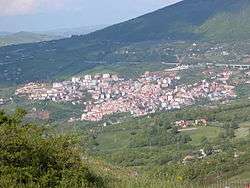Tito
Tito may refer to:
People
Family name
Given name

Tito, Basilicata
Tito is a town and comune in the province of Potenza, in the Southern Italian region of Basilicata. It is bounded by the comuni of Abriola, Picerno, Pignola, Potenza, Sant'Angelo Le Fratte, Sasso di Castalda, Satriano di Lucania, Savoia di Lucania.
External links
1550 Tito
1550 Tito, provisional designation 1937 WD, is a stony asteroid and somewhat slow rotator from the inner regions of the asteroid belt, about 12 kilometers in diameter. It was discovered by Serbian astronomer Milorad B. Protić at the Belgrade Astronomical Observatory, Serbia, on 29 November 1937.
The S-type asteroid orbits the Sun at a distance of 1.8–3.3 AU once every 4 years and 1 month (1,483 days). Its orbit shows an eccentricity of 0.31 and is tilted by 9 degrees to the plane of the ecliptic. It has a relatively long rotation period of 54.2 hours and an albedo in the range of 0.20–0.26, according to the surveys carried out by the Japanese Akari satellite and the Wide-field Infrared Survey Explorer and subsequent NEOWISE mission.
It was named in honour of Josip Broz Tito (1892–1980), leader of the Yugoslavian resistance during the World War II, early enthusiast of the United Nations, and president of former Yugoslavia.
References
External links

Square (album)
Square is a studio album by Canadian hip hop musician Buck 65. It was released on WEA in 2002. Though it consists of four tracks, each track consists of multiple songs.
It was nominated for the 2003 Juno Awards for Alternative Album of the Year and Album Design of the Year.
Reception
Rollie Pemberton of Pitchfork Media gave Square a 7.0 out of 10 and called it "a melodic mix of folk rock sensibility, smooth early 90s style production, clever lyrical observations and a relatively enjoyable train ride into the mental station of Halifax's best-known emcee." Meanwhile, Clay Jarvis of Stylus Magazine gave the album a grade of B+, saying, "Square is built solely out of his strengths: hazy introspection, sparse snare-and-kick beats and simple, dismal instrumental refrains."
Track listing
References
External links
Square (band)
HIDDEN ERROR: Usage of "Inspired by" is not recognized
Square was a short-lived musical trio from Lincoln, Nebraska who moved to Southern California in early 2000. It was composed of Sean Beste (vocals and keyboards), James Valentine (guitars) and Ryland Steen (drums). Their sound has been described as including elements of rock, pop, and jazz fusion.
The band moved to Orange County after entering an Ernie Ball-sponsored band competition. They won the grand prize, beating 600 other entrants. Shortly after winning the competition, they released their only full-length album, This Magnificent Nonsence, on an indie label called Lucy Smith Music. The band started playing many gigs in the area, including some with local band Kara's Flowers.
In 2001, the members of Kara's Flowers asked Valentine to join their group, an invitation that he accepted, effectively dissolving Square. Kara's Flowers changed its name to Maroon 5 and became one of the most commercially successful acts of the mid-2000s. Steen later joined the established ska band Reel Big Fish. Beste (who was initially upset and unhappy by Valentine's decision to leave Square but says he no longer harbors any ill will) started a band called The Excuse and moved to Portland, Oregon for several years. He has since returned to the Los Angeles area and has done some work with the band Maxeen.

Square (company)
Square Co., Ltd. (株式会社スクウェア, Kabushiki-gaisha Sukuwea) was a Japanese video game company founded in September 1983 by Masashi Miyamoto. It merged with Enix in 2003 and became Square Enix. The company also used SquareSoft as a brand name to refer to their games, and the term is occasionally used to refer to the company itself. In addition, "Squaresoft, Inc" was the name of the company's American arm before the merger, after which it was renamed to "Square Enix, Inc".
History
Square was founded in Yokohama in September 1983 by Masashi Miyamoto after he graduated from Waseda, one of Japan's top universities. Back then, Square was a computer game software division of Den-Yu-Sha, a power line construction company owned by Miyamoto's father. While at the time game development was usually conducted by only one programmer, Miyamoto believed that it would be more efficient to have graphic designers, programmers and professional story writers working together on common projects. Square's first two titles were The Death Trap and its sequel Will: The Death Trap II, both designed by part-time employee Hironobu Sakaguchi and released on the NEC PC-8801.
Podcasts:

